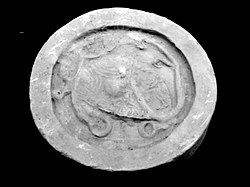Top Qs
Timeline
Chat
Perspective
Black Turtle-Snake
Chinese mythology symbol From Wikipedia, the free encyclopedia
Remove ads
The Black Tortoise is one of the Four Symbols of the Chinese constellations. It is usually depicted as a tortoise intertwined with a snake.[1]
According to Eastern Han philologist Xu Shen, the character 武 (wǔ) meant 士 (shì "knight") in the Jianghuai dialect.[2] So the English translation Black ~ Dark ~ Mysterious Warrior is a more faithful translation.[3][4]
It represents the north, thus it is sometimes called Black Warrior of the North (北方玄武; Běifāng Xuánwǔ).
While neither character 玄 or 武 literally means tortoise or snake; but tortoises and snakes are known to hibernate during winter, so 玄武 as a whole represents the season of winter.
The image of intertwined tortoise and snake likely symbolizes a state of inner struggle.[citation needed]
In Japan, the characters 玄武 are pronounced as Genbu. It is said to protect Kyoto on the north side, being one of the four guardian spirits that protect the city. It is represented by the Kenkun Shrine, which is located on top of Mount Funaoka in Kyoto.
An important Taoist priest also has 玄武 Xuanwu as his clergy name. He is sometimes (as in Journey to the West) portrayed in the company of a turtle and a snake.
Remove ads
History
During the Han dynasty, people often wore jade pendants that were in the shape of turtles. Originally, there was a legend that said that turtles could not mate with other turtles, only snakes. This is why the Black Tortoise is depicted with a snake on its back.
The northern gates of Chinese palaces were often named after the Xuanwu. Most famously, the Incident at Xuanwu Gate, where Li Shimin killed his brothers Jiancheng and Yuanji and seized power in a coup, took place at the north gate of the Taiji Palace, in the north of Chang'an.
Remove ads
Legends
Summarize
Perspective

In ancient China, the tortoise and the serpent were thought to be spiritual creatures symbolizing longevity. The Min people custom of building turtle-shaped tombs may have had to do with the desire to place the grave under the influence of the Black Tortoise.[5][6]
Xuanwu

In the classic novel Journey to the West, Xuanwu was a king of the north who had two generals serving under him, a "Tortoise General" and a "Snake General". This god had a temple in the Wudang Mountains of Hubei and there are now a "Tortoise Mountain" and a "Snake Mountain" on opposite sides of a river near Wuhan, Hubei's capital. Taoist legend has it that Xuanwu was the prince of a Chinese ruler but was not interested in taking the throne, opting instead to leave his parents at age 16 and study Taoism. According to the legend, he eventually achieved divine status and was worshiped as a deity of the northern sky.
Other Chinese legends[citation needed] also speak of how the "Tortoise General" and a "Snake General" came to be. During Xuanwu's study to achieve enlightenment and divine status, he was told that, in order to fully achieve divinity, he must purge all human flesh from his body. Since he had always eaten the food of the world, despite all his efforts, his stomach and intestines were still human. A god[which?] then came and changed his organs with divine ones. Once removed, the original stomach and intestines were said to have become a tortoise and a snake, respectively. The tortoise and snake became demons[citation needed] and terrorized people. Now divine, Xuanwu heard of this and returned to slay the monsters he had unleashed on the countryside. However, as the snake and tortoise showed remorse, he did not kill them but instead let them train under him to atone for their wrongdoings. They then became the Tortoise and Snake generals and assisted Xuanwu with his quests (another legend held that the mortal organs were tossed out to become Wuhan's Tortoise and Snake mountains).
According to another source,[citation needed] once Xuanwu had begun his study of the Way, he discovered that he must purge himself of all of his past sins to become a god. He learned to achieve this by washing his stomach and intestines in the river. Washing his internal organs, his sins dissolved into the water in a dark, black form. These then formed into a black tortoise and a snake who terrorized the country. Once Xuanwu learned of this, he returned to subdue them as in the other story.
Remove ads
Seven Mansions of the Black Tortoise
As with the other three Symbols, there are seven astrological "Mansions" (positions of the Moon) within the Black Tortoise. The names and determinative stars are:[7][8]

See also
- Ao – the great turtle of early Chinese mythology
- Bixi – the son of the Dragon King who supports Chinese stelæ
- Cetus in Chinese astronomy – Cetus and Black Tortoise correspond on astrology, and both creatures possess affinities to waters and travel to underworlds to guide people[9][10]
- Dragon turtle – a similar creature
- Fushigi Yûgi: Genbu Kaiden
- Gamera – the fictional kaiju being repeatedly referenced to the Black Tortoise
Remove ads
Notes
References
External links
Wikiwand - on
Seamless Wikipedia browsing. On steroids.
Remove ads


